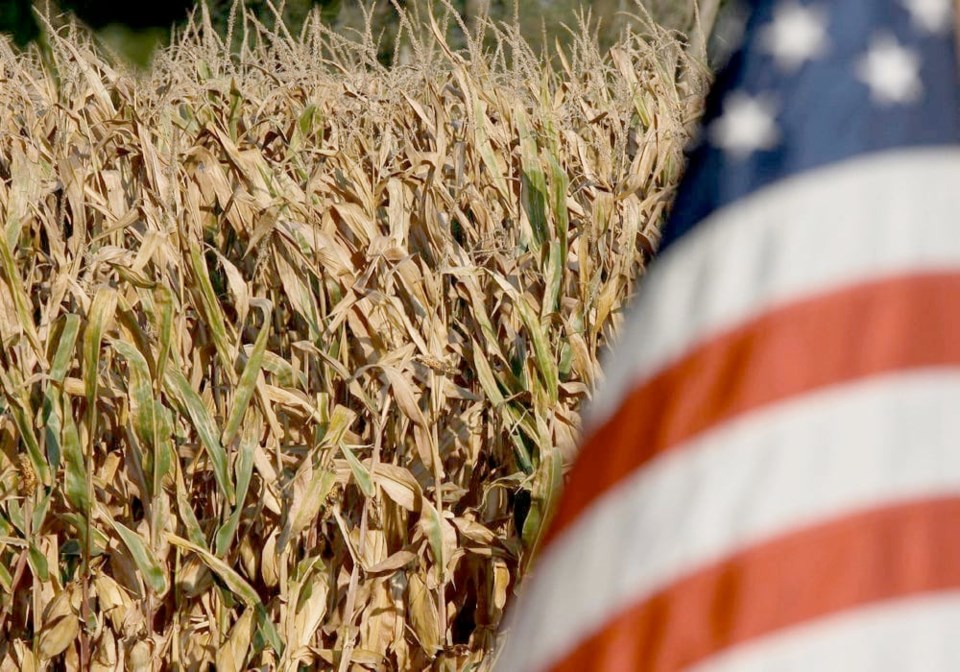WESTERN PRODUCER — The U.S. Department of Agriculture’s latest U.S. corn yield estimate does not reflect reality, says an analyst.
The USDA dropped its national average corn yield for 2023-24 to 177.5 bushels per acre, down from its forecast of 181.5 bu. a month ago.
DTN lead analyst Todd Hultman thinks that is still too high. He thinks it will end up closer to 175 bu. per acre based on current conditions in the Midwest.
“I understand that maybe they don’t want to get out ahead of themselves before they go out and get a better look at the crop,” he said during a DTN webinar on the USDA’s July World Agricultural Supply and Demand Estimates report.
But he noted that the latest U.S. Drought Monitor map is similar to the one from 2012, which was a dismal year for U.S. crop yields.
“Both of these maps had 63 percent D1 to D4 (drought) ratings in the Midwest region,” said Hultman.
However, the temperatures were hotter in 2012 than they have been in 2023 and the forecast for July and August back then was for much drier weather than what is supposed to transpire this year.
But nobody expects the current drought to completely disappear this summer either.
“You’d have to think that that’s going to be costing these crops some yields,” he said.
That’s why he takes issue with the USDA’s forecast for 389.15 million tonnes of corn production.
“We’ll see if that stands the test of time. Personally, I doubt that it will,” said Hultman.
The USDA is forecasting 57.45 million tonnes of U.S. corn ending stocks for 2023-24.
“If true, that would be the most we’ve seen in seven years for corn,” said Hultman.
Arlan Suderman, chief commodities economist with StoneX, said the corn outlook is grim due in a large part to lacklustre U.S. exports of the commodity.
He said it is hard to imagine the U.S. meeting the USDA’s 53.34 million tonne corn export forecast for 2023-24 given Brazil’s record crop and China’s lacklustre demand for the commodity.
“The one thing that could turn that around is if we have a major crop failure in China and El Nino is giving them havoc,” said Suderman.
“They have areas that are too dry, too hot, too wet. They’re having a mess of weather over there.”
The USDA kept its soybean yield unchanged at 52 bu. per acre.
“This is not surprising because in the case of soybeans, those yields tend to be heavily influenced by weather in late July and August,” said Hultman.
But what was surprising was the USDA’s forecast for 8.16 million tonnes of U.S. soybean ending stocks, up from 6.95 million tonnes in 2022-23.
The trade was expecting a much lower number of 5.6 million tonnes.
Arlan Suderman, chief commodities economist with StoneX, said weather models are calling for a “rather mild” July and August, which should help soybean yields.
But he still thinks yields will end up closer to 50 bu. per acre, rather than the 52 the USDA is forecasting.
“I’m much tighter than what the USDA is,” he said.
Only 56 percent of the U.S. soybean crop rated good to excellent as of July 9, which is the lowest rating for that period since 2012.
Soybean exports have been performing much better than corn.
And crush margins are terrific, with soybean oil and meal fetching a US$2.59 per bu. premium over soybean seed.
“That’s a very generous, very profitable return for soybean processors,” said Hultman.
Wheat yields are forecast at 46.1 bu. per acre, up from the 44.9 bu. estimate in June. Harvested acres also increased to 37.7 million acres, up from 37.1 million a month ago.
U.S. wheat production is estimated at 47.33 million tonnes, well above the trade estimate of 45 million tonnes heading into the report. That is mainly because of better-than-anticipated winter wheat yields.
Wheat ending stocks are forecast at 16.12 million tonnes, which while bigger than last month is still low historically speaking.
Global wheat stocks (excluding China) are also forecast to be tighter than normal.
“But prices have had a very heavy lid on them here in 2023, and that doesn’t seem to be changing quite yet,” said Hultman.
The immediate market reaction to the report was decidedly bearish, with December corn futures falling $0.1775 per bu., November soybeans dropping $0.3250 and Kansas September wheat down $0.14 the day the report was released on July 12.




